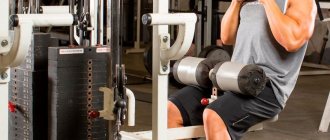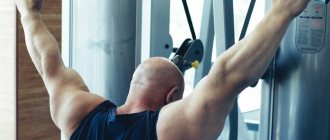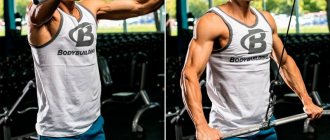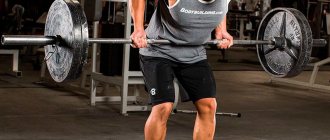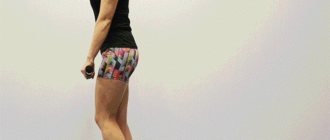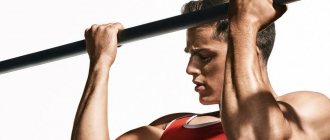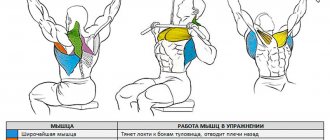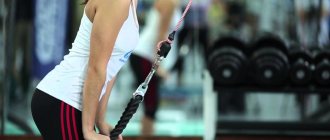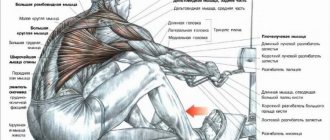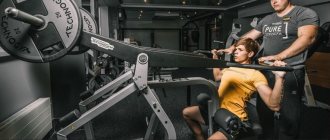One of the best basic exercises for working the middle and lower back. A reverse grip is used so that you can slightly change the load and engage muscles that are not involved in the classic grip.
We recommend reading: Exercises on the back exercise machine
Typically, the reverse-grip lat pulldown is used as an additional exercise in a training program. It is recommended to do the following on the day of back work:
- The biceps takes an active part in the pull-down of a vertical block with a reverse grip.
- The exercise is essentially an analogue of pull-ups, but the only difference is that the trainee can independently choose how much weight to pull.
- The good thing for beginners is that they can take it lighter, while more experienced ones can use more weight than their own body weight.
- The exercise is well suited both as a warm-up before the main basic exercises and as a final exercise for “finishing” the target muscles.
- Pulling down on the chest is considered quite safe, the risk of injury is minimal.
What muscles work
Main movers:
- Both are wide;
- Rhomboid muscles;
- Biceps
Movement aids and stabilizers:
- Large pectorals;
- Press;
- Trapezoidal;
- Muscles of the palm and forearm;
- Longus dorsi muscle
During the exercise, static tension in the muscles of the thighs and buttocks is possible if the athlete is accustomed to resting his feet on the floor in order to help himself well during the training process. But this should not be considered as a training activity. Trapezius work (shoulder lifts) is also discouraged and is only done if the lifter is advanced enough to perform the movement with a slight cheat.
Training your back correctly
Any effective technique for gaining muscle mass cannot ignore both of these exercises. Let us consider, as an example, a training complex of this technique, designed to work out the back muscles. So, the first exercise is wide-grip pull-ups. To maximize your back work, you need to get as much training stress as possible, which will be the result of training the muscle through the full range of motion. The full range of movement is possible in this exercise only when the hands are located at such a distance from each other that, with the shoulders parallel to the bar, the forearms should also be parallel to each other and perpendicular to the plane of the floor.
Wide grip lat pulldown to chest
The exercise develops back thickness by increasing the load on the middle of the latissimus muscles.
What muscles work
- Latissimus dorsi muscles.
- Teres major muscle.
- Biceps brachii.
- Shoulder muscles.
- Additionally included: trapezius muscle, rhomboid muscle, pectoralis major muscle.
Execution technique
- Place a wide handle on the upper block, grab it from above with a wide grip.
- Lower yourself into the seat with your arms extended above your head. Place your hips under the special fixing rollers.
- Lean your body back slightly, maintaining this position throughout the approach.
- As you exhale, bend your elbows and , using the efforts of your back muscles, bring your shoulder blades together , bringing the handle to the clavicular part of your chest, while protruding your chest, forming a deflection.
- Do not touch the sternum with the handle; fix the tension at the lowest point.
- As you inhale, smoothly straighten your elbows, maintaining the position of your body.
- At the top point, smoothly straighten your arms, gently stretching your shoulder joints, without jerking.
- Repeat the movement.
Upper pulley to the chest in video format
We recommend reading: How to do the splits in a month at home
Vertical block row for girls: what is good?
You can often read that TVB makes it possible to create the ideal symmetry of the figure, desired by many men.
But it is precisely for this reason that most girls avoid this exercise completely in vain. In fact, it is perfect for women too. With TVB, not only the back muscles are pumped, but also the rear bundles of deltoid muscles, triceps, biceps and forearm. Accordingly, even if you are unable to do pull-ups, thanks to this movement, you can work several muscle groups at the same time, and also improve your strength in the future. TVB for women can serve a wide variety of purposes. With this movement you can develop explosive strength, work on relief or mass. The range of influence of TVB and its potential is practically inexhaustible.
Work of muscles and joints
When performing block rows with a reverse grip to pump up the latissimus dorsi muscles, the latissimus muscles, teres major muscle, trapezius muscle, forearm and biceps receive the main load. When an athlete wants to focus the load on the biceps, then in addition to the target muscle, the latissimus is also loaded, and all other muscle groups do not receive the load. The bottom line is that the biceps is a small muscle, so training it together with other muscles is problematic, since it is difficult for the body to use it. In this regard, there is a need for its careful isolation, although if the biceps is genetically predisposed to growth, then on the contrary it can interfere with the development of the latissimus muscles, then it is necessary to select exercises for the back that do not allow the biceps to steal the load.
The number of working joints that are involved during the performance of the lat pulldown with a reverse grip again depends on the emphasis on what the athlete is performing the exercise. If the target muscle is the latissimus, then the load is distributed between the shoulder and elbow joints, just as with a regular lat pulldown. If an athlete sets himself the task of loading the biceps, then the work occurs in only one joint - the elbow, and the shoulders are fixed. The need for such isolation arises because otherwise it is impossible to exclude unnecessary muscle groups from work. However, both options for performing deadlifts are safe, since the weight does not put pressure on the joints from above, but, on the contrary, pulls them upward.
Benefits of Bent Over Rows
Bent-over barbell rows with a reverse grip are popular because they can be used to work out the entire middle of the back. The exercise has the following benefits:
- building a beautiful figure;
- building muscle mass;
- development of back strength;
- strengthening the back muscle corset;
- working out small supinator muscles;
- development of grip strength, which allows you to progress in the barbell press and deadlift (relevant for the male part of the gym).
The barbell row is one of the three most effective exercises for developing the back. Despite this, for some reason many people are more fixated on block simulators. But exercises with free weights (barbells, dumbbells) are the best, including for girls.
What muscles work during lat pulldowns?
The main purpose of the lat pulldown is to train the wings (latissimus dorsi). Secondary stress falls on the biceps, shoulders and forearms. In total, the exercise involves about 9 muscle groups, including trapezius, deltoids, pectoralis major and minor, rhomboids, and triceps.
The full muscle atlas is shown in the photo:
- Who is the exercise intended for : lat pulldowns replace pull-ups on the horizontal bar for girls. For men - it is a means for deep and detailed study of the back muscles.
All upper block traction options
There are different traction options. They differ in complexity, execution technique, muscle atlas, etc.
Upper block traction options:
- To the chest
- Per head
- Wide
- Narrow
- Back
- Parallel
FEATURES AND TECHNIQUES
Wide grip overhead pull-down
Benefit of the exercise : actively trains the wings and muscles near the shoulder blades. Used to create a beautiful back relief.
We recommend reading: Cat exercise for the back
Execution technique:
- Sit facing the cargo stack, keeping your back strictly upright.
- Tilt your head down slightly to avoid accidentally injuring the back of your head.
- Using the force of your wings, pull the bar down (by bringing your shoulder blades together).
- Hold the weight for 1-2 seconds and return to the starting position.
- Repeat the exercise 10-15 times.
The overhead pull-down is quite dangerous, so we recommend performing the exercise under the supervision of a trainer.
Possible mistakes:
| Error | How to |
| Lowering the bar too low | Place your hands behind your head slightly (optimally to the back of your head) |
| Use the widest possible grip | Hand position is comfortable, slightly wider than shoulder width |
How to learn to do pull-ups?
First, let's figure out why women find pull-ups so difficult?
The female body is biologically more resistant to external influences. However, some loads that are easily tolerated by men are too much for women. Simply put, a woman is better at long-term, low-intensity exposure, while a man is better at short-term, high-intensity tasks. How does this relate to training?
Unlike men, it is more difficult for women to do pull-ups; moreover, even with intense and properly organized training, not all women will be able to do pull-ups well. In push-ups, presses and rows for the superficial back muscles, the results will also be lower on average. In addition, a relatively weak upper body often limits performance in the deadlift and even the squat. BUT this is not a reason to conclude that women should train differently. The means (exercises) and methods (magnitude of load, number of approaches and repetitions) do not differ between women and men.
According to the results of a few studies, the strength of the upper body of women is 43–63% less, and the strength of the lower body is 25–30% less than that of men.
But still.. HOW TO LEARN TO PULL UP? FROM SCRATCH
Let's rid each other of the same type of advice like “strengthen your back/arms”, “play sports”, etc. I think this is already obvious. Here are the details you're likely missing.
- Correct grip:
Your fingers should be pointing towards you and your thumb should be gripping the bar from below. There are several types of grip that you can use when performing the movement, but this is a good place to start. Why? Yes, because the load with a reverse grip will be greater on the biceps, and it is larger in structure and can withstand a more serious load than the triceps.
Strong wrists
Strengthen your wrists by hanging for a minute
To do a pull-up, it's important to have a fairly strong wrist, which most of us don't have. Grab the bar with an overhand grip and straighten your arms
Hang as long as you can first. Ideally, bring this exercise to 60 seconds. To make the task more difficult, hang small weights of 1-2 kg on your legs or shoulders.
Another good way to develop weak wrists
Negative repetitions. (see picture)
Beginners should use negative repetitions. To do this, you need to lift it above the horizontal bar using, say, a chair. If the crossbar is located on a wall bars, then this is simply an ideal option. Place your feet on it and grab the bar from above. When you have taken the starting position, begin to slowly lower down. After this, rise again to the starting position and perform the next repetition. Perform 3 to 5 repetitions in this mode, 5–7 repetitions each.
By the way, a repetition is considered valid when the chin rises above the level of the crossbar.
Insurance
Ask for someone to back you up while doing pull-ups. As soon as you already feel the strength to completely do this exercise, you will need an assistant in the person of a trainer, the most handsome man in the gym or a girlfriend.
Grab the bar from above, hang and try to pull yourself up to chin level on your own. If at any level you don't have the strength, have a helper push you up a little. In the process of training, you will be able to do without it.
Execution technique
Initial position:
- Take your starting position in the machine, facing the pulley system.
- Grasp the bar with a reverse (supinated) grip at shoulder level so that your forearms are approximately parallel to each other.
- Holding the handle with your arms extended, sit on the bench and place your knees under the bolsters.
- Keeping your lower back vertical, move your chest forward so that the cable of the exercise machine is in the projection of the solar plexus. Hold this position for the rest of the set.
Movement:
- As you exhale, contract your lats and with an isolated movement of your elbows, pull the handle down to your chest. At the extreme point, pull your elbows back and bring your shoulder blades together as much as possible.
- After holding this position for a few seconds, inhale and straighten your arms under control, sending the block to the starting position.
- Perform the planned number of repetitions of deadlifts.
Attention!
Calculate your ideal sports weight!
- Do not “cut off” the range of motion so as not to reduce the impact of the exercise. The optimal way to work the latissimus muscles is to pull the handle of the block to the clavicular area of the chest.
- Do not lean your body back, so as not to create potentially “favorable” conditions for a back injury. Maintain natural lordosis in the lumbar region (lower back at right angles to the floor) and arch in the thoracic region.
- Don't tilt your chin towards your chest. On the contrary, direct your gaze to the pulley system to better control the correct position of your back.
- Do not neglect retracting your shoulder blades at the lowest point of the amplitude when pulling the bar to your chest. This allows you to reduce your back muscles as much as possible.
Recommendations!
- Try to exclude your arms from the movement as much as possible and concentrate the load in your back. To do this, concentrate on moving your elbows.
- Hold the handle with a bear grip (thumb on top, in line with the rest) to minimize the participation of the forearm muscles in the exercise.
- Fully straighten your elbows as you return to the starting position to better stretch your muscles and work through an expanded range of motion.
- Avoid jerking when performing rows and lifting your pelvis off the bench. They not only reduce the effectiveness of the exercise due to the resulting moment of inertia, but also increase the risk of injury to the spine, ligaments and joints. If this happens, reduce your workload.
Execution options!
- Vertical block row with a narrow reverse grip . By “narrow” in this case we mean placing the hands at shoulder level (the distance between the hands is no more than 20 cm). This technique allows you to shift the emphasis to the bottom of the latissimus and slightly increase the load on the biceps muscle. However, this option is rarely used for targeted pumping of the biceps, since even with this technique it is quite difficult to isolate it.
Possible mistakes
Men and women who have not previously performed vertical block rows on a machine conduct independent training without the help of an instructor and make the following most common mistakes:
- spread the elbow joints to the sides;
- selecting too much or too little weight for the simulator block;
- throw their head back;
- fall to the right or left side, which is fraught with injury, deformation changes in the structure of the spinal column;
- make too strong a deflection in the lumbar spine;
- they slouch and do not ensure that their back remains as straight as possible while pulling a vertical block;
- perform jerks and sudden movements with their hands, which do not allow creating an accentuated load on the muscles of the back, shoulder girdle and trapezius;
- The shoulder blades do not move back.
The above mistakes do not allow you to achieve a positive result in the development of the latissimus dorsi muscles, biceps, shoulder girdle and trapezius. The athlete only wastes personal time and physical effort without receiving the expected increase in muscle mass. Leaning to one side, twisting the back, or slouching during exercise can lead to spinal deformation.
Preparing for the exercise
Adequate technique can only be achieved if the feet are planted on the floor and the hips are locked. Therefore, it is important to adjust the pad of the exercise machine so that the athlete’s hips rest against the clamps, and are not “slipped” under them. Your shins should be perpendicular to the floor and your posture should be stable.
The exercise is convenient to perform with a wide handle, or with a special straight notched handle for a reverse grip. In some exercise machines, you need to attach a chain or adapter to the block structure so that it is convenient for your height to pull the upper block to your chest. In the initial position, standing on the floor, the athlete must reach the handle independently.
This exercise can be either the first for a beginner or performed towards the end of the workout. In any case, a joint warm-up and 1-2 warm-up approaches are required to approach the weight.
How to implement it into training
This exercise is suitable for both men and girls, both beginners and professionals. The main thing is to choose a training regimen and weight that suits your strength, taking into account your preparation and goals.
- For beginners and those looking to strengthen their muscles and prepare them for a free-weight base, it is recommended to perform light-weight deadlifts for 15 to 25 repetitions. Regardless of whether you will gain weight or lose weight in the future, you need to start with this particular regimen. The primary task is to strengthen the muscles and ligaments.
- At the initial stage of training for the back, two exercises aimed at different goals and parts of the muscles will be quite enough. For example, both close-grip and wide-grip rows are needed. If the reverse grip row will develop the thickness of the lats, then the row behind the head will develop the width.
- Advanced athletes are recommended to perform pull-downs after exercises with their own or free weight: pull-ups, deadlifts, barbell rows.
It is important to use the exercise for the purpose of gaining mass using the following method: 8-12 repetitions of 3-4 approaches. The working weight, accordingly, needs to be increased so that the last repetitions can be performed until the muscle fails.
